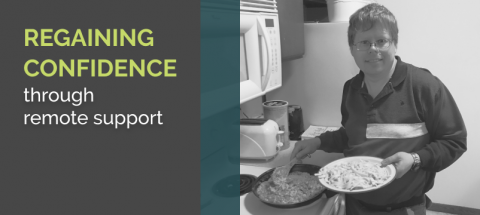Regaining Confidence Through Remote Support

Expert contributor: Tamara Twite, CCRI
Going from having caregiver support 24 hours a day to just nine hours per week seems unimaginable, right? Who is making sure the individual is safe? Who is making sure they are getting to work on time or taking their medications?
A 159 hour per week drop in caregiver hours seems dramatic. That’s because it is—but in a good way. Ryan Sebelius was able to achieve greater independence while decreasing his need for in-person support through the use of remote support technology. Though not “traditionally” supported 24 hours a day as he was before the addition of technology, he is certainly not without support during the times a caregiver isn’t physically present in his home.
The Move to Remote Supports
Living on his own was always Ryan’s goal. He chose CCRI’s Supported Living Services program in 2006 to first develop critical skills for living more independently, such as stable medication management. At the time, he received 24 hour care and received help in managing his medications to make him less “hyper”, as he would say. Once his medication was on track, his next move was to CCRI’s Independent by Design program (IBD) where he uses remote monitoring in conjunction with direct caregiver hours to provide increased independence while matching his support needs.
Ryan is very independent and does an outstanding job at the day-to-day tasks of life. Reassurance that he is doing a good job is what he needs most. Technology provided that reassurance and helped create a smooth transition to independent living.
The Technology
Remote supports consist of sensors that are placed around a home that alert staff to a need. Alerts from sensors trigger a phone call to the assigned caregiver. In IBD, there is a caregiver in a nearby office 24 hours a day, 365 days a year, to help individuals when a need arises. Caregivers respond to technology alerts, maintain the tech, and help with any other issues that come up.
At Ryan’s apartment, a front door sensor details comings and goings, and, because Ryan loves to cook (he is very proud of his pumpkin sloppy joes), a stove sensor was placed in a drawer next to the stove which notifies staff and Ryan if the temperature exceeds a certain level. On a weekly basis, Ryan, now independently, sets up his medications. In the beginning, a sensor was placed on his medication cabinet which let staff know when he was accessing his medication (by tracking when the cabinet opens and closes). With the consistency of the technology reminders, Ryan gained the independent routine to take his medications without the need for reminders.
How it works for Ryan
“Since beginning in IBD Ryan has become more outgoing and will stretch himself by trying new things—he just seems to beam.” Said Eric Hilber, SLS Director. Using remote support technology, Ryan is able to live safely in his own home—independently.
Since implementing the technology, Ryan’s in-person caregiver hours have gone from 24 hours a day to just nine hours per week. He no longer needs the sensors on his medication dispenser, he fills his automatic medication manager independently, and reorders his medications as needed. With his newfound independence, he is able to relax more, sleep in when able, and enjoys quieter mornings which he appreciates.
Technology can fulfill the desire for independence, while still maintaining the safety of the individual by instilling confidence and the assurance needed to achieve life goals. Often times following a technology implementation, it is found that certain supports are able to be removed as individuals become more confident and routines are solidified. Technology is there when needed, provides reassurance, and is easily modified as needs change.
Visit the ARRM Technology Resource Center to learn about more success stories and case studies showing how technology is changing the lives of those living with disabilities or learn more about how to start the conversation.



